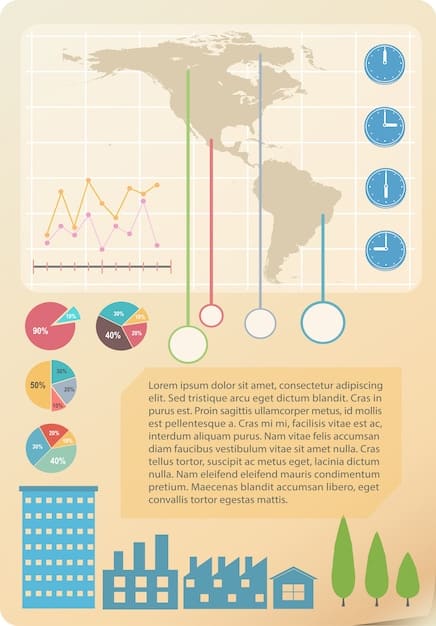Decoding US Climate Change Policy: Impact of International Agreements

Decoding the US Stance on Climate Change: What Does the Latest International Agreement Mean for American Diplomacy? involves examining how recent global accords influence American foreign policy, considering both the commitments made and the impact on US diplomatic strategies and international relations.
The United States’ approach to climate change is a complex interplay of domestic priorities and international obligations. Decoding the US Stance on Climate Change: What Does the Latest International Agreement Mean for American Diplomacy? requires understanding how these factors shape foreign policy decisions and influence global climate action.
US Climate Policy Evolution
The evolution of US climate policy reflects shifting political landscapes, economic considerations, and scientific advancements. Understanding this history is crucial for interpreting the nation’s current stance and future trajectory regarding international climate agreements. The US has moved from initial denial to cautious engagement, and finally, to more active participation.
Early Stages of Climate Awareness
In the early days of climate change awareness, the US response was characterized by skepticism and limited action. This period saw the emergence of scientific consensus on climate change, but the government’s response was slow due to economic and political factors.
Kyoto Protocol and US Response
The Kyoto Protocol, a landmark agreement aimed at reducing greenhouse gas emissions, highlighted the differences in approach between the US and other nations. The US signed but did not ratify the protocol, citing concerns about its potential economic impact and the lack of binding commitments for developing countries.
- Economic Concerns: The US worried about the competitiveness of its industries if it adopted strict emission reduction targets.
- Fairness: Policymakers argued that developing nations like China and India should also face binding commitments.
- Domestic Opposition: Strong resistance from industries and conservative political groups hindered ratification.
Ultimately, the US chose a different path, focusing on voluntary measures and technological solutions rather than binding international agreements. This decision had significant implications for global climate negotiations and the US’s role on the world stage.

The Paris Agreement: A Turning Point?
The Paris Agreement marked a potential turning point in US climate policy, with the nation committing to ambitious emission reduction targets. However, the subsequent withdrawal from the agreement under a different administration and the eventual rejoining highlight the ongoing volatility and domestic divisions surrounding this issue.
US Commitments Under Paris
Under the Paris Agreement, the United States pledged to reduce its greenhouse gas emissions by 26-28% below 2005 levels by 2025. This commitment required significant policy changes and investments in renewable energy and energy efficiency measures.
Withdrawal and Rejoining
The withdrawal from the Paris Agreement in 2020 sent shockwaves through the international community, undermining global efforts to combat climate change. However, the decision to rejoin the agreement in 2021 signaled a renewed commitment to climate action and international cooperation.
- Political Divisions: The withdrawal highlighted the deep political divisions within the US regarding climate change.
- International Relations: The decision strained relationships with allies and undermined US credibility on climate issues.
- Economic Impacts: The impact on US industries and the transition to a clean energy economy remain subjects of debate.
Despite these challenges, the US re-entry into the Paris Agreement underscores its importance in addressing climate change and the need for global cooperation. This move has paved the way for renewed international negotiations and collaborations.
Impact on American Diplomacy
The US stance on climate change has profound implications for its diplomatic relations and its role in shaping global environmental governance. Understanding these impacts involves examining how climate issues influence bilateral and multilateral engagements.
Bilateral Relations
Climate change has become a key agenda item in US bilateral relations, influencing discussions on trade, security, and development. The US seeks to leverage its diplomatic influence to encourage other nations to adopt more ambitious climate targets and policies.
Multilateral Engagements
The US plays a significant role in multilateral forums such as the United Nations Framework Convention on Climate Change (UNFCCC) and the G20. These engagements provide opportunities to shape international norms and standards on climate change.
- UNFCCC: The US actively participates in negotiations under the UNFCCC, advocating for transparency, accountability, and ambitious emission reduction targets.
- G20: Climate change is a regular topic of discussion at G20 summits, where the US seeks to promote collective action and commitments.
- Climate Finance: The US has pledged to provide financial assistance to developing countries to support their climate mitigation and adaptation efforts.
Through these engagements, the US aims to foster international cooperation and advance its climate agenda on a global scale. However, success depends on building trust and navigating complex political dynamics.

The Latest International Agreement
The latest international agreement on climate change represents a significant step forward in global efforts to address this pressing issue. Analyzing its specific provisions and potential impacts is critical for assessing its overall effectiveness.
Key Provisions
The agreement includes provisions on emission reduction targets, adaptation measures, climate finance, and technological cooperation. These provisions reflect the collective commitment of nations to work together to combat climate change.
Potential Impacts
The agreement has the potential to accelerate the transition to a low-carbon economy, promote climate resilience, and enhance international cooperation. However, its success depends on effective implementation and robust monitoring mechanisms.
- Emission Reduction: The agreement aims to achieve deeper emission cuts, aligning with the goals of the Paris Agreement.
- Adaptation: It emphasizes the importance of building resilience to the impacts of climate change, particularly in vulnerable regions.
- Climate Finance: The agreement seeks to mobilize significant financial resources to support climate action in developing countries.
While the agreement faces challenges, it represents a vital step in advancing global climate action. Its implementation will require ongoing commitment and collaboration from all nations.
Challenges and Opportunities
The US faces both challenges and opportunities in implementing its climate policies and engaging in international agreements. Overcoming these challenges and capitalizing on opportunities is crucial for achieving its climate goals and strengthening its diplomatic relations.
Economic Challenges
The transition to a clean energy economy poses economic challenges for certain industries and regions. Addressing these challenges requires strategic investments in job training, infrastructure development, and technological innovation.
Political Challenges
Political divisions within the US continue to hinder progress on climate policy. Building consensus and fostering bipartisan support is essential for ensuring long-term commitment and effective implementation.
Despite these challenges, the US is well-positioned to capitalize on emerging opportunities in clean energy, green technology, and sustainable development. These opportunities offer the chance to create jobs, boost economic growth, and enhance its global competitiveness.
Future Directions in US Climate Diplomacy
Looking ahead, US climate diplomacy will likely focus on strengthening international partnerships, promoting clean energy technologies, and advancing climate resilience. These efforts will shape its role as a leader in global climate action.
Strengthening Partnerships
The US will seek to strengthen its partnerships with other nations, particularly those committed to ambitious climate goals. This collaboration will facilitate the sharing of best practices, technological innovation, and financial resources.
Promoting Clean Energy
The US will actively promote the deployment of clean energy technologies, both domestically and internationally. This involves investing in research and development, supporting renewable energy projects, and fostering international cooperation on technology transfer.
Advancing Climate Resilience
The US will prioritize efforts to enhance climate resilience, particularly in vulnerable regions. This includes providing financial and technical assistance, sharing best practices in adaptation, and promoting climate-resilient infrastructure development.
By pursuing these strategies, the US can solidify its role as a global leader in addressing climate change and promoting sustainable development. This leadership will be essential for achieving the goals of the Paris Agreement and building a more resilient and prosperous future for all.
| Key Point | Brief Description |
|---|---|
| 🌍 Paris Agreement | US committed to emission reductions, withdrew, then rejoined. |
| 🤝 American Diplomacy | US uses diplomacy to influence global climate action. |
| 🌱 Clean Energy | US promotes clean energy technologies for sustainability. |
| ⚖️ Challenges | Economic and political divisions hinder climate policy progress. |
Frequently Asked Questions
The US initially committed to reducing its greenhouse gas emissions by 26-28% below 2005 levels by 2025. This target has been updated with a more ambitious goal for 2030.
The US withdrew due to concerns about the perceived economic disadvantages and unfair burden on American businesses. The decision was part of a broader policy shift.
Climate change is now a key consideration in US diplomatic engagements, influencing discussions on trade, security, and development with other nations. It’s a central topic.
The transition to a clean energy economy poses challenges for certain industries and regions, requiring investments in job training and infrastructure development to mitigate negative impacts.
The future involves strengthening international partnerships, promoting clean energy, and enhancing climate resilience, positioning the US as a global leader in addressing climate change effectively.
Conclusion
In conclusion, the US stance on climate change remains a dynamic and evolving aspect of its foreign policy. The latest international agreements significantly influence American diplomacy, requiring a delicate balance between domestic priorities and global responsibilities. By understanding the historical context, current challenges, and future opportunities, the US can effectively navigate the complexities of climate diplomacy and contribute to a sustainable future.





